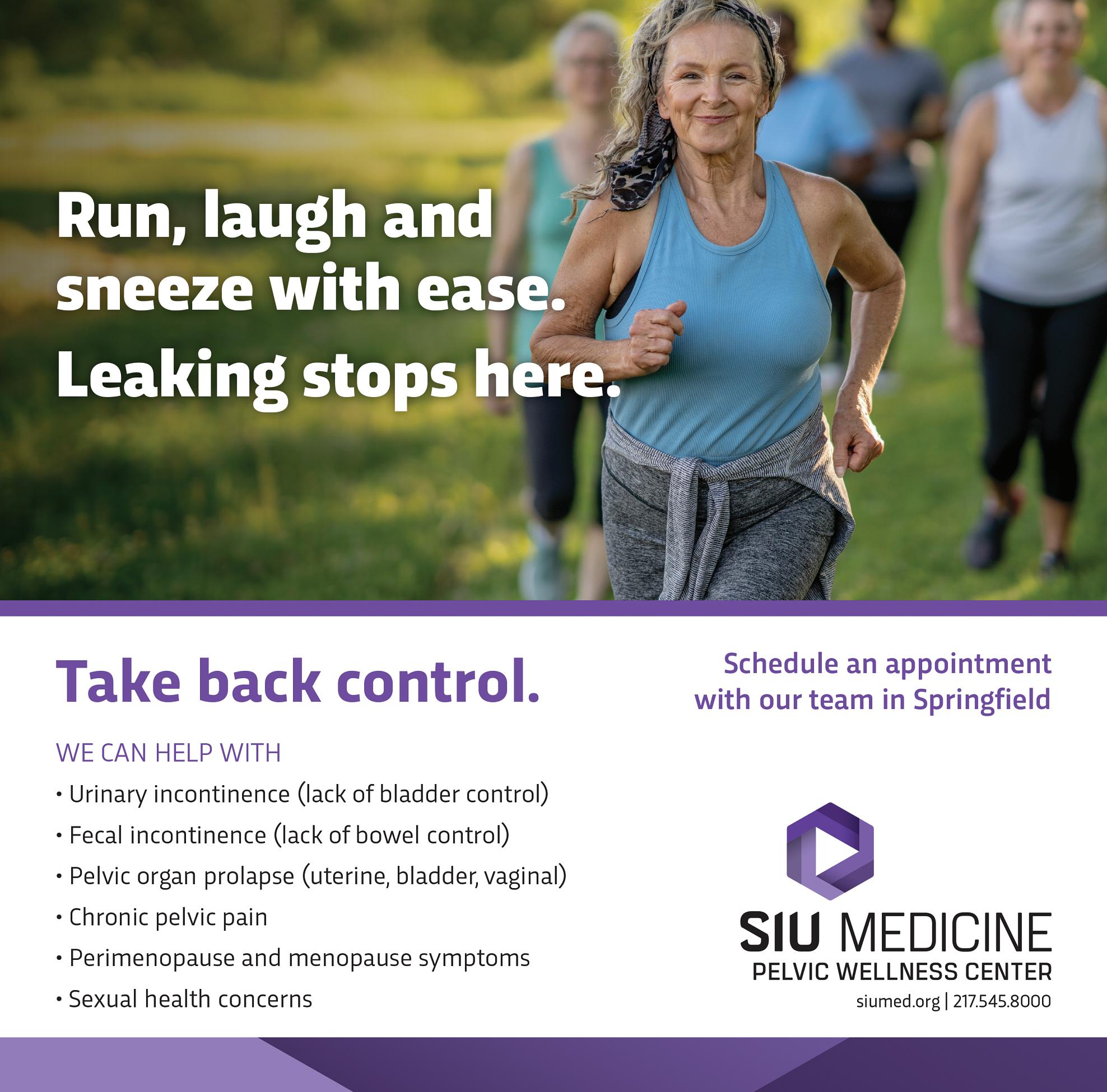























A Special Supplement to the
























By: ReBecca Budde SIu MedIcIne
When you’re a referee, you’re trained to keep your eye on the ball. For Jackie Slayback of Heyworth, Ill., that focus shifted from the court to her own body, specifically, her bladder.
“I work full time and I referee, so I live a pretty active life,” Jackie said. “But for three years, I had to self-catheterize. I always had to think about it. It was really limiting.”
Jackie had been seeing a provider who helped her manage her bladder leakage for years with BOTOX® treatments. The treatments worked well. But after a routine treatment, Jackie began experiencing complications, was unable to empty her bladder naturally and eventually needed to use a catheter. “I’m not sure exactly what happened,” she said. “But after that one visit, I ended up catheterizing for three years.” She tried to find help elsewhere. “I saw a gynecologist, but I felt like I got brushed off,”
she said. So she did what many of us do in moments of frustration and desperation: she turned to Google.
That’s how Jackie discovered the Pelvic Wellness Center at SIU Medicine, where she recognized a familiar name: Samuel Grampsas, MD.
“I had actually seen Dr. Grampsas 20 years earlier when he was practicing in Bloomington. I trusted him then, and I figured, why not see if he could help again?”
Jackie was right to trust her instincts. Dr. Grampsas found that in addition to pelvic organ prolapse and other complications, a leftover piece of surgical mesh from a previous procedure had worked its way into her urethra. He performed a bladder lift, repaired the prolapse and removed the mesh.
“I’m really glad Jackie came in when she did,” said Dr. Grampsas. “Her prolapse and the exposed mesh would have continued to cause
pain and dysfunction. These issues don’t resolve on their own; in fact, they tend to get worse.”
Finding the right health care team and getting her the right surgical treatment made all the difference. “The Pelvic Wellness Center team members were all awesome,” Jackie said. From the initial consultation and dealing with insurance to checking in on Jackie after her surgery, Jackie knew she had partners who cared about her health. “I couldn’t have asked for or received better care or responsiveness to my questions and concerns–before, during and after surgery. It was so nice to have someone in my corner and advocating for me.”
“The biggest milestone?” Jackie grinned. “After the Foley catheter came out post-surgery, I didn’t need to cath anymore. I still carry one with me, just in case, but I haven’t needed it since. That’s freedom.”
Bladder incontinence is more common than most people realize. It affects millions of women
and can be incredibly isolating.
“It’s not something we want to talk about,” Jackie said. “But I want others to know: You’re not alone. And you don’t have to just live with it.”
Dr. Grampsas, a board-certified urologist and leader in female pelvic medicine and reconstructive surgery, says stories like Jackie’s are all too familiar. “Bladder leakage and pelvic floor disorders are underreported and undertreated,” he said. “A lot of people assume nothing can be done, or they’re too embarrassed to ask for help. But treatment is available, and for many patients, it’s life-changing.” For Jackie, it’s about getting her life back. “I can get back to doing the things I love without constantly planning around my condition. I tell all my friends: It’s worth the drive to SIU. The Pelvic Wellness team listens, they care and they gave me my freedom back.”









Parents face no shortage of challenges when raising their children. Some challenges are overcome easier than others, but one that tends to have more staying power than most is the difficulty some parents experience as they try to get their children to eat healthy diets.
A 2024 poll from C.S. Mott Children’s Hospital found that 27 percent of parents of children between the ages of three and 10 indicate their youngsters don’t like healthy food and more than half indicate their kids are picky eaters. Such responses underscore the challenges parents face as they attempt to raise healthy eaters. Despite those challenges, many parents have met with considerable success in their efforts to raise healthy eaters, and various strategies can facilitate those efforts.
• Recognize that being picky at the dinner table is normal. It’s undeniably frustrating for parents when kids are picky about their food, but childcare experts note such behavior is normal. The Children’s Hospital of Philadelphia note that children across the globe go through a phase marked by picky eating between the ages of two and four. So parents can make a concerted effort to remain patient if kids suddenly become picky about what they eat. Most grow out of the phase soon enough.
• Remain patient when presenting healthy foods. Just as patience is paramount when navigating the picky eating phase, it’s important to remain so when introducing new foods like vegetables and other healthy fare. The CHOP notes that studies have found kids may not accept new foods until it’s been offered as much as 15 times, so parents must remain patient if the nutritious foods they’re offering are
new to kids’ diets.
• Invite kids to choose and prepare meals. Giving kids some agency over what they eat and asking them to pitch in during meal prep can make them more excited about mealtime regardless of what’s on their plate. UCLA Health notes there are a range of kid-friendly meal preparation tasks. Kids can wash fruits and vegetables in the sink, tear leafy greens and even measure ingredients as they get older.
• Visit a local farm. Some kids may be more excited to eat healthier foods like fruits and vegetables after visiting a local farm and seeing where the foods are grown. Parents can start by visiting farms that grow healthy foods that kids are more likely to eat, such as strawberries and blueberries. A day spent picking apples in the fall also might encourage youngsters to eat more fruit.
• Limit dinner table distractions. Distractions at the dinner table, like smartphones, tablets and toys that were not cleared away before sitting down to eat, can prolong mealtime, which can make kids less enthusiastic about eating. In a report from the CHOP, Dr. Katherine Dahlsgaard of the hospital’s Department of Child and Adolescent Psychiatry and Behavioral Sciences noted that kids get the majority of their calories in the first 20 minutes of a meal. Setting a happy, distraction-free tone at the start of a meal can get kids eating and reduce the chances they lose interest in what’s on their plate.
A nutritious diet benefits kids in the shortand long-term. Though it’s not always easy to get kids to eat healthy, parents can employ various strategies to accomplish that goal.



Aches, pains and creaks are not uncommon among the aging population. A lifetime of living can take a toll on the human body, so it’s normal to experience some periodic side effects from all that wear and tear. But some issues may stem from more than normal wear and tear, and in such instances it can be useful to visit a chiropractor.
The Cleveland Clinic notes chiropractors treat an assortment of conditions that affect the nervous system and the musculoskeletal system. Many people prefer chiropractic care as an alternative to treatments that utilize prescription medication, and it’s worth noting the many conditions that may be treated and alleviated by chiropractic care.
• Arthritis: Arthritis is a common condition, particularly among
adults age 50 and older. In fact, the Centers for Disease Control and Prevention notes that one in five adults in the United States had arthritis in 2024, while the Global RA Network estimates more than 350 million people have the condition across the globe. The Cleveland Clinic notes normal, lifelong wear and tear is often the cause of arthritis, and chiropractors can employ various techniques to alleviate the pain associated with this common condition.
• Headaches: It might surprise people unfamiliar with chiropractic care to learn that it’s not uncommon for people with headaches to seek the help of a chiropractor. The Canadian Chiropractic Association
notes that chiropractic care has been found to be an effective means to treating cervicogenic and tension headaches. Chiropractors may employ various treatments, including soft tissue therapy and acupuncture, to alleviate headache pain.
• Lower back pain: Chiropractic care has long been looked to as a means to alleviating lower back pain. The experts at Duke Health note that chiropractors may employ spinal manipulation to treat back pain before offering additional advice, including self-care recommendations, to help patients avoid recurrence. Manual manipulation to improve movement in the spine may be part
of chiropractic treatment of lower back pain.
• Neck pain: Chiropractors also can help treat neck pain. Many people experience limited mobility in their neck and/or soreness or joint pain in this area. A subluxation is a slight misalignment of the vertebrae that can contribute to pain, stiffness and reduced function in the neck. Chiropractic care works to restore vertebra to the correct position with the hopes that such a restoration will alleviate pain and improve mobility and function.
Chiropractic care can be an invaluable solution when individuals suffer from aches, pains and creaks that can affect the human body over time.
Breast cancer is a formidable disease that affects millions of individuals each year. Data fromm the World Health Organization indicates 2.3 million women were diagnosed with breast cancer in 2022, when it was the most common form of the disease in 157 of 185 countries across the globe.
The impact of breast cancer goes beyond those diagnosed with the disease, affecting friends, family members, professional colleagues, and others as well. That far-reaching impact means everyone has a vested interest in learning about breast cancer.
What is breast cancer?
The Centers for Disease Control and Prevention notes breast cancer occurs when cells in the breast grow out of control. The breast is made up of three main parts known as the lobules, ducts and connective tissue, and which type of breast cancer a person has depends on which cells in the breast turn into cancer. Is there a typical breast cancer?
No two individuals diagnosed with breast cancer will have the same experience after being diagnosed.
However, the CDC notes that most breast cancers
begin in the ducts or lobules. The ducts are tubes that carry milk to the nipple and the lobules are the glands that produce milk. What are some common risk factors for breast cancer?
The National Breast Cancer Foundation, Inc. notes gender is the foremost risk factor for breast cancer, as the WHO reports that 99 percent of breast cancers occur in women. Additional risk factors for breast cancer include age, with two out of three women diagnosed with invasive breast cancer being older than 55, and race, as the disease affects more Caucasian women than women of other races.
The NBCF also notes that women who have dense breast tissue may be at greater risk for breast cancer because such tissue can make it harder to detect lumps. What causes breast cancer?
The NBCF notes that most women who have breast cancer will never be able to identify an exact cause behind their disease. Common risk factors like gender and age are beyond women’s control, but there are some controllable risk factors that can be avoided. The WHO notes that overconsumption of alcohol and tobacco use are two such factors.

How important is early detection?
The American Cancer Society reports that the five-year survival rate for breast cancers discovered in the localized stage is
99 percent. That underscores the significance of early detection. The NBCF notes monthly breast self-exams and routine clinical exams increase the likelihood of early
detection. Women are urged to speak with their physicians regarding how frequently they should be tested, as recommendations vary depending on each individual and their respective family histories. The basics of breast cancer provide insight into the disease and what women can do to reduce their risk of developing it.


Breast cancer is marked by the formation of malignant cells in the various tissues of the breast. Family history and other factors like age increase a person’s risk for breast cancer. According to the National Cancer Institute, the most common type of breast cancer is ductal carcinoma, which begins in the cells of the ducts and accounts for roughly 70 to 80 percent of all breast cancer cases. Ten to 15 percent of all breast cancer cases are lobular carcinoma, which begins in the lobes or lobules. After a person is diagnosed with breast cancer, a cancer care team will begin to discuss treatment options. It’s important to weigh all options carefully. By understanding breast cancer treatments beforehand, individuals can make more informed decisions should they need to. The following are some treatment options for breast cancer.
• Surgery: Breast cancer surgery typically involves a process to remove the cancer. A lumpectomy is a surgery that removes the tumor and some healthy tissues around it. This usually is reserved for a small cancer. Others may have a mastectomy to remove all of the breast tissue, including lobules, ducts, fatty tissue and some skin.
A sentinel node biopsy may be needed to see if the cancer has spread to nearby lymph nodes. In some cases, removing several lymph nodes is necessary if the cancer has spread.
• Radiation: Radiation treatment employ high-energy rays or particles to destroy cancer cells. Radiation can be used to help lower the chances that the cancer will come back after breastconserving surgery. It also can be used if cancer has spread to other parts of the body. The American Cancer Society says external beam radiation therapy is the most common type of radiation therapy for women with breast cancer.
• Chemotherapy: Chemotherapy involves anticancer drugs that may be injected or administered orally. The drugs travel throughout the bloodstream to reach cancer cells in most parts of the body. Chemotherapy may be given before surgery to shrink a tumor or afterwards to kill any cancer cells left behind or ones that may have spread. Since chemotherapys is systemic, it can affect all areas of the body and may result in various side effects, according to the NCI.
• Hormone therapy: Hormone therapy may be recommended for postmenopausal women who have been diagnosed with metastatic breast cancer that is hormone receptor positive or if the hormone receptor status is unknown. As the medications block certain hormones that some breast cancers are sensitive to, the cancer growth is stunted. Blocking the hormones also can cause the cancer cells to die, says the Mayo Clinic.
• Targeted therapy: Targeted therapy utilizes medicines that attack specific chemicals in cancer cells. By blocking these chemicals, the treatment can cause cancer cells to die. The ACS says 15 to 20 percent of breast cancers make too much of a protein known as HER2. The most common targeted therapy medicines target HER2.
• Immunotherapy: Immunotherapy boosts a person’s own immune system with certain medications to recognize and destroy cancer cells. A cancer care team may use any combination of breast cancer therapies to stall the growth of the cancer and stop it from coming back.
The choices people make have a far-reaching impact. The consequences of some decisions are apparent almost immediately, while other choices may not produce noticeable results for years to come. In regard to liver health, today’s choices may not have an immediate impact but will have a significant impact over the long haul. The American Liver Foundation notes the liver is one of the most vital organs in the human body, playing a notable role in natural detoxification and metabolism, among other important functions. With so much to gain from a healthy liver, it’s worthwhile for anyone to learn the lifestyle choices that can affect the longterm health of this highly important organ.
• Excessive alcohol consumption: The ALF notes that excessive alcohol consumption can increase risk for a range of health conditions that can lead to liver damage. Hepatitis, cirrhosis and steatotic liver disease, which was once known as fatty liver disease, are all potential byproducts of overconsumption of alcohol. The
National Institute on Alcohol Abuse and Alcoholism notes that “heavy drinking” is characterized by four or more drinks on any day or eight or more per week for women, and five or more drinks on any day or 15 or more per week for men. The NIAAA reports heavy drinking is more common than many people may realize, with studies from the group suggesting as many as 50 percent of adults who drink engage in binge drinking.
• Movement: It’s easy to think of behaviors like excessive drinking that have a negative impact on liver health, but it’s equally important that people recognize the positive impact that certain lifestyle choices can have on their livers. The ALF notes that a physically active lifestyle in which adults get the recommended 150 minutes of moderate aerobic activity each week can improve liver health over time. Walking and cycling are two examples of accessible aerobic activities that adults
can engage in to promote long-term liver health.
• Dietary decisions: The foods people eat have a profound effect on their short- and long-term health, and those choices affect the liver as well. When people consume an excessive amount of calories, the body converts some of those calories into fat, which might then be stored in the liver. When that occurs, a person’s risk for steatotic liver disease increases. The ALF urges individuals to choose healthy, liver-friendly fats when planning their diets. Fatty fish such as salmon, nuts, seeds, avocados, and olive oil contain liver-friendly fats, while foods such as red meat, dairy products like butter and cheese, and desserts like ice cream can compromise liver health.
Lifestyle choices go a long way toward determining liver health. Adults concerned about the health of their livers are urged to embrace various lifestyle choices that can have a positive impact on this vital organ.





